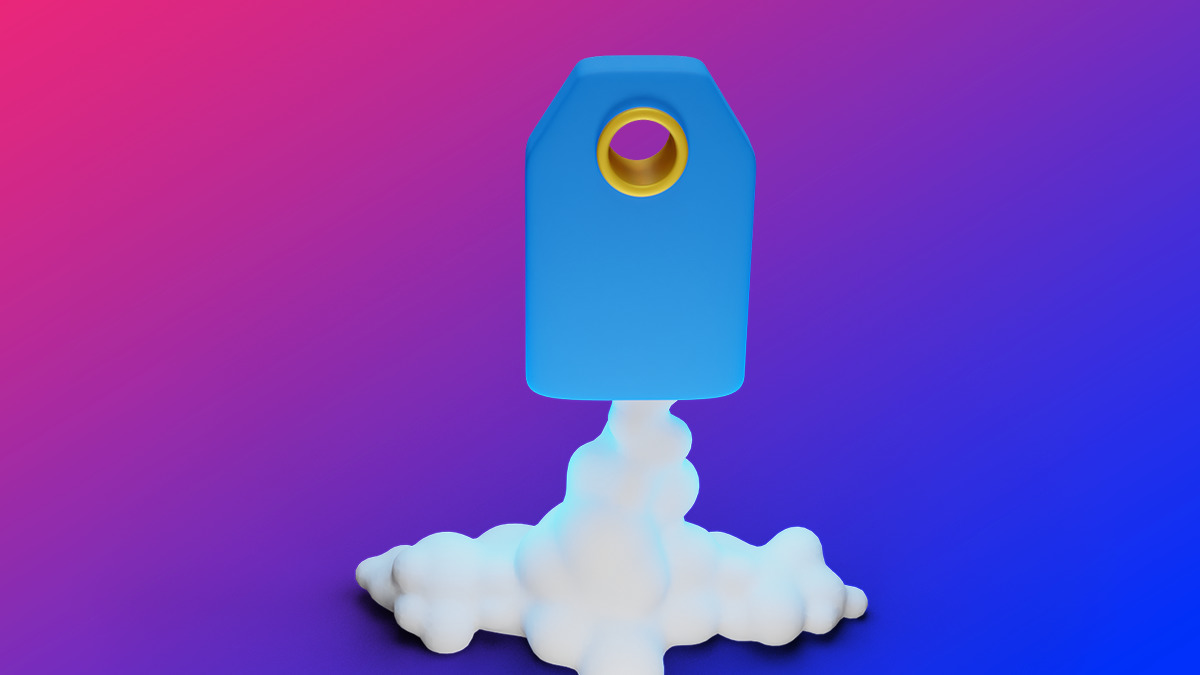
Each person on your email list is unique: In a real conversation, you wouldn’t talk to VIP clients in the same way you would talk to new leads. So why would you send them the same email? Short answer: You shouldn’t.
You can use tags and segments to send emails that cater to the specific needs and interests of your subscribers. Tagging is easier — and more important — than you think. Here’s why:
The days of one-size-fits-all email marketing are gone. Your audience expects to get interesting emails — with topics they care about. But your subscribers are snowflakes! They don’t all care about exactly the same things.
The more your audience likes your emails, the more they will open your emails: it’s simple psychology. So to get the best results, you need to send multiple targeted, personalized emails rather than one general email to everyone.
By delivering hyper-relevant content to those who are most interested in it, your subscribers will open, click, and purchase more.
Don’t worry, it’s not rocket science to do! In this post, we’ll cover how to use tags to create more targeted segments (or groups) of subscribers and increase your engagement.
What is an email tag?
Tags are simple words or short phrases you use to categorize and group your subscribers based on their interests, behaviors, or other shared attributes.
For example, you could add “prospects” and “customers” tags to your subscribers based on whether they’ve bought from you yet.
Or, a cookbook author could add tags for “vegan,” “paleo,” and “vegetarian” to their subscribers — indicating which recipes that group may be interested in seeing.
In essence, tags are simply labels composed of a few words to help organize and classify your contacts. Think of tags as virtual sticky notes about a specific subscriber that tells you more about them than just their name and email address.
For example, you can add email marketing tags automatically when a subscriber:
- Fills out a custom field on your sign up form
- Takes a specific action on your website
- Interacts with an email or landing page.
You can also bulk-add tags to a group of your subscribers during or after uploading them into your email account.
Apply tags to each of your subscribers at any time — later, when you’re sending emails, you can offer more targeted content and even trigger automated campaigns.
What is the difference between an email list and an email tag?
An email list is a group of people who have opted-in for your emails because they have an interest in your content or products. You can set up one list and tag your contacts based on what you know about them. Or you can set up multiple email lists based on different sign up forms or landing pages.
The downside of having multiple lists is that you can have the same contact on different lists. For example, someone is on your product list because they brought a product, but they are also on a lead magnet list because they downloaded a piece of free content. If you send the same content to different lists, people on more than one list may receive duplicate contact.
But using one large list without tags can be risky, too. Without categorizing your subscribers appropriately you run the risk of sending irrelevant email content to some of your subscribers.
How do you use tags in emails?
Simply categorizing your subscribers with tags is important; but the true value comes into play when you use these tags to send different types of content to different audiences.
For example, the cookbook author from above may send two emails promoting their new cookbook:
- To subscribers tagged “vegan” they use a vegan pasta recipe to promote the book
- To all other subscribers, they show a salmon recipe to promote the book
The same book has recipes for everybody, but the author is likely to sell more copies by sending recipes relevant to each group of subscribers.
The first, and maybe most important, part of tagging for email is deciding how to categorize your subscribers — which tags should you give them?
Related video: How do I use tags in my email marketing.
Having a hard time thinking of tags to add to your audience? Get some inspiration from these 15 ways you can tag your subscribers:
15 types of subscriber tags (to help you send better emails)
1 - Sign up form
The easiest way to tag a subscriber is when they opt in to your email list using a sign up form.
You can create multiple sign up forms and apply different tags to subscribers when they fill out different forms. This way, you’ll know exactly which form a subscriber used to sign up.
For example, if you offer a 7-day email course, weekly newsletter, and downloadable checklist as lead magnets, you can have three separate sign up forms that apply unique tags to your subscribers. This lets you see quickly which lead magnets they signed up for.
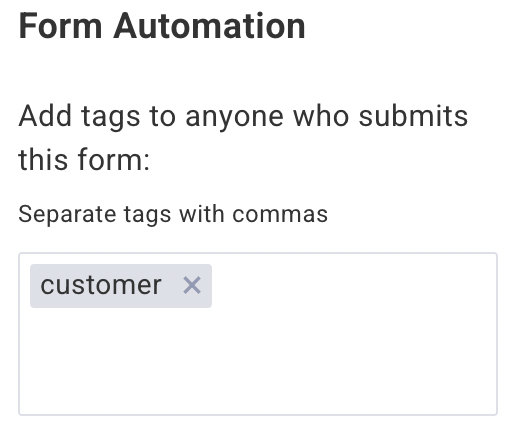
Related: How to tag an AWeber sign up form
2 - Custom field data
Let’s say you want to know a bit more about your subscribers at the time they sign up, such as what topics they’re interested in, or their experience level in a particular skill you teach.
You can collect this additional information, beyond just their name and email address, using custom fields on your sign up form, and you can associate a tag with each custom choice.
This allows you to segment your subscribers from the time they join your list, and create personalized experiences for each of them.
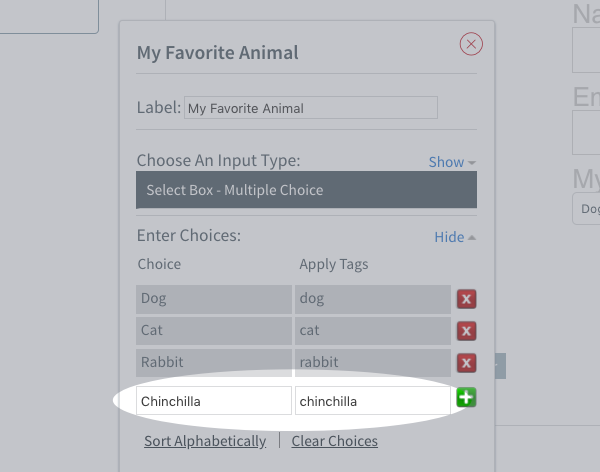
Related: How to tag a custom field in an AWeber sign up form
3 - Met at an event
Do you attend in-person events? You can create a sign up form on your mobile device to collect subscribers’ information in person, and use tags to remind you which event you met them at.
And if you attend multiple events, you can change which tags. That way, you know where you met each particular subscriber.
You can even set up an automated welcome email series ahead of time to go out to each new subscriber you met at the event.
Here's the landing page we used at Podcast Movement to get podcasters signed up for our newsletter:
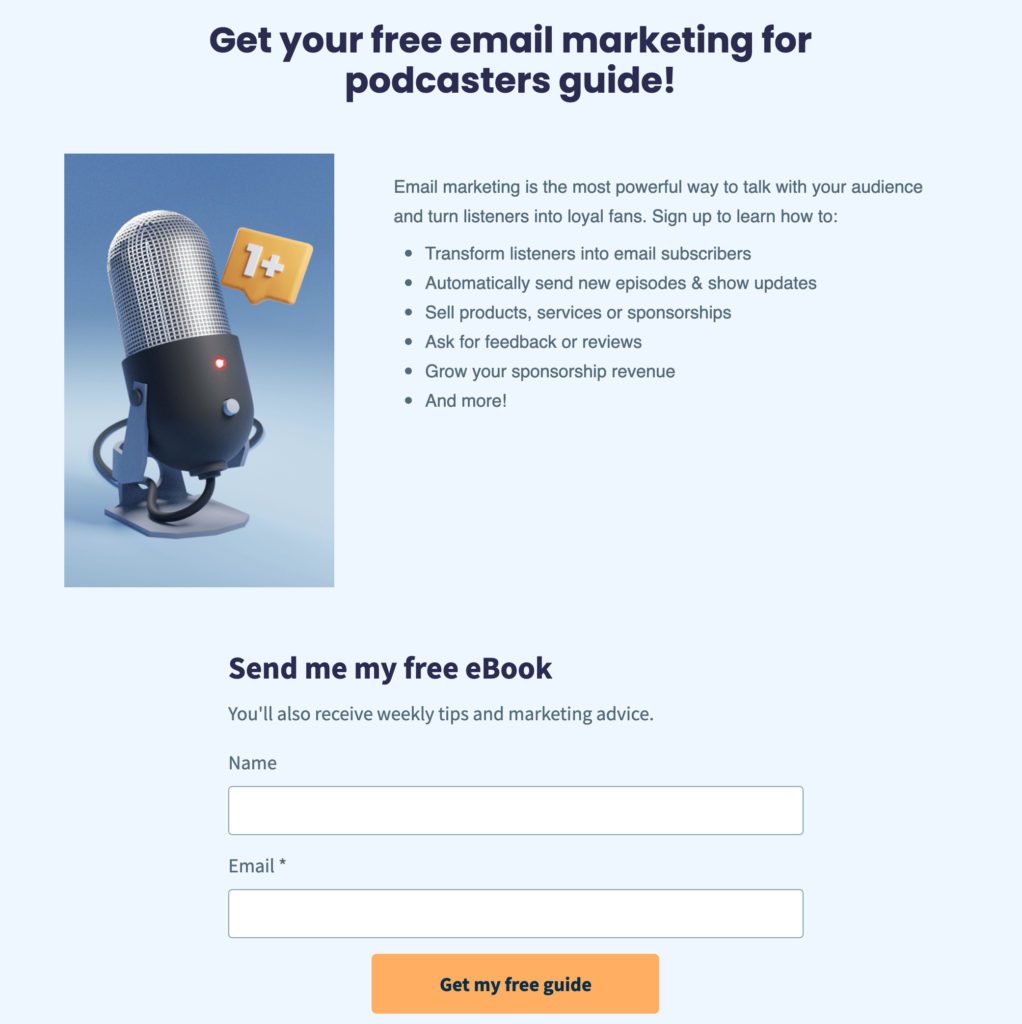
4 - Quiz completion
Quizzes are a great way to provide a fun, interactive, and educational experience for your audience. Tools like Interact and Quiz Cat allow you to create engaging quizzes, then you can tag your subscribers who complete your quiz.
5 - Webinar attendee
Webinars are a great way to engage your audience directly and provide educational content to your subscribers. Tools like EasyWebinar allow you to add your webinar registrants directly to your email provider, and tag them based on the webinar they signed up for.
Then, you can automate reminder emails and follow up with your registrants after the webinar to share the recording and special offers.
You can even tag people based on whether they came to the webinar, stayed the whole time or left early, and if they watched the playback.
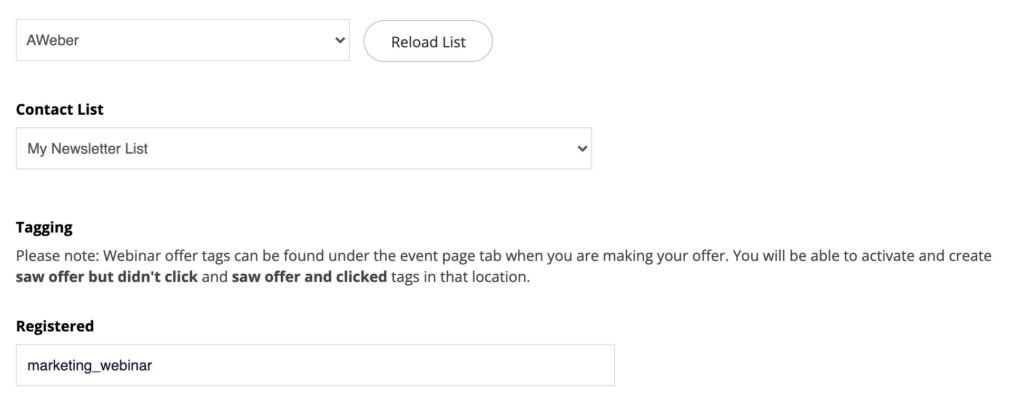
6 - Contest entrance
Contests are a great way to engage your community and grow your email list. Using tools like Gleam or ViralSweep, you can automatically add contest participants to your email list, and tag them based on the contest they joined.
7 - Price quote request
Do you offer quotes, online calculators, polls or chatbots as part of your business? Tools like Outgrow allow you to add your interested prospects automatically to your email provider. Tag them accordingly, so you know exactly who they are and what they expressed interest in.
8 - On purchase
When a customer makes a purchase, apply tags for each product purchase. You can do this using AWeber's Ecommerce tool or through an integration with Shopify, WooCommerce, PayPal, etc.
Next time you send an email you can personalize it by sending them similar products that they are more likely to purchase.
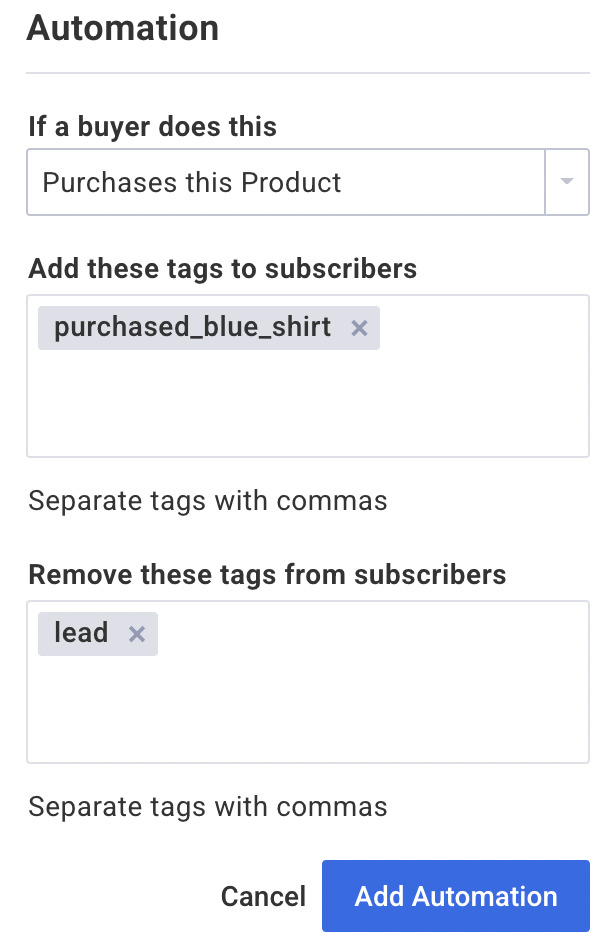
9 - Abandoned cart
You can tag a subscriber who left items in their cart and didn’t purchase them. Use this tag to send them an automated email to encourage them to finish their purchase.
You can apply a generic tag when someone abandons any purchase, or you can apply unique tags based on the product that someone abandons.
Related: How to set up cart abandonment with Shopify
10 - Starts automated campaign
One way to tag subscribers is when they begin a campaign. This is helpful if you want to easily identify subscribers who are currently going through a Campaign so you don’t send them your regular broadcast emails as well.
Once they complete the Campaign, you can automatically remove that tag.
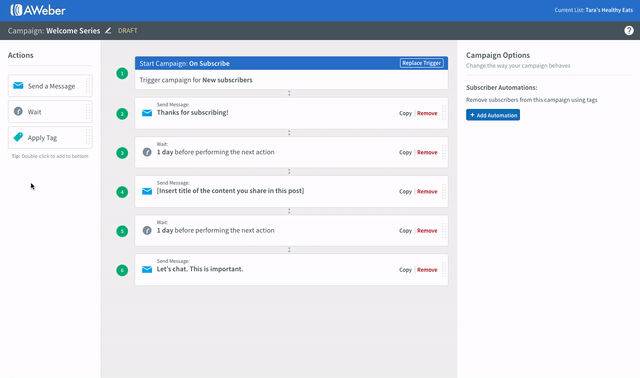
Related: How to use tags at the beginning of a Campaign
11 - Finishes automated campaign
Another way to tag subscribers in a campaign is at the end of the series. This allows you to link campaigns together.
For example, you may have multiple welcome campaigns for different sign up forms, and you may want them all to flow into a general nurture campaign after each welcome campaign is complete. Simply apply the same tag at the end of each campaign, and then set the general nurture Campaign to start on that tag.
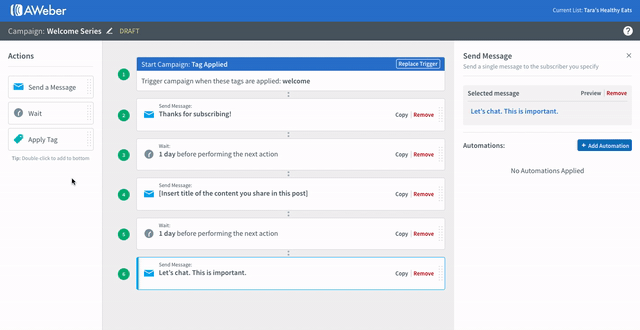
Related: How to use tags at the end of a Campaign
12 - Opens email in a campaign
Tags can also be used to record specific actions your subscribers take within your campaign. For example, you can tag subscribers when they open specific messages in your campaign.
This helps you identify subscribers who expressed an interest in the topic of the email by opening it.
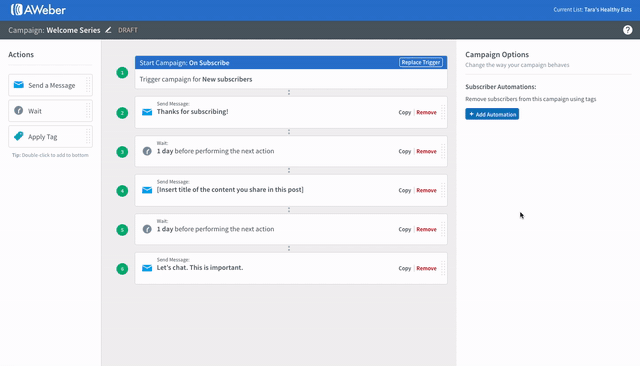
Related: How to add a tag when someone opens a message in a Campaign
13 - Clicks a link in a campaign
Similarly, you can tag subscribers when they click specific links within the messages of your campaigns. This is helpful when you’re trying to learn more about your subscriber’s preferences.
For example, in our blog welcome campaign, we ask what our subscribers are interested in learning, and we provide links within that email. Each link has a different tag, and it allows our subscribers to self-select their interests so we can better target them with relevant content.
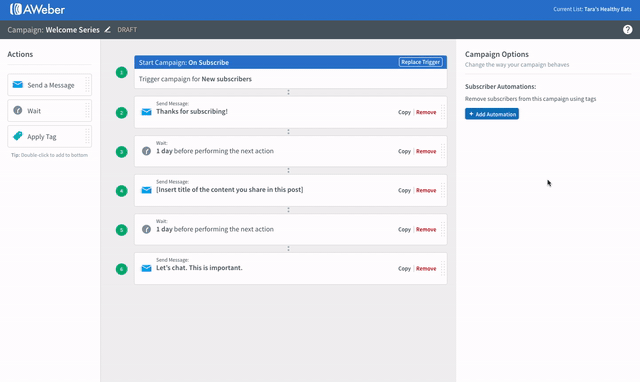
Related: How to add a tag when someone clicks a link in a Campaign
14 - Opens a broadcast email
You can also tag subscribers when they open one-time, broadcast emails. Similar to tagging subscribers who open your Campaign messages, this helps you identify who is interested in the topic of the email enough to want to open it.
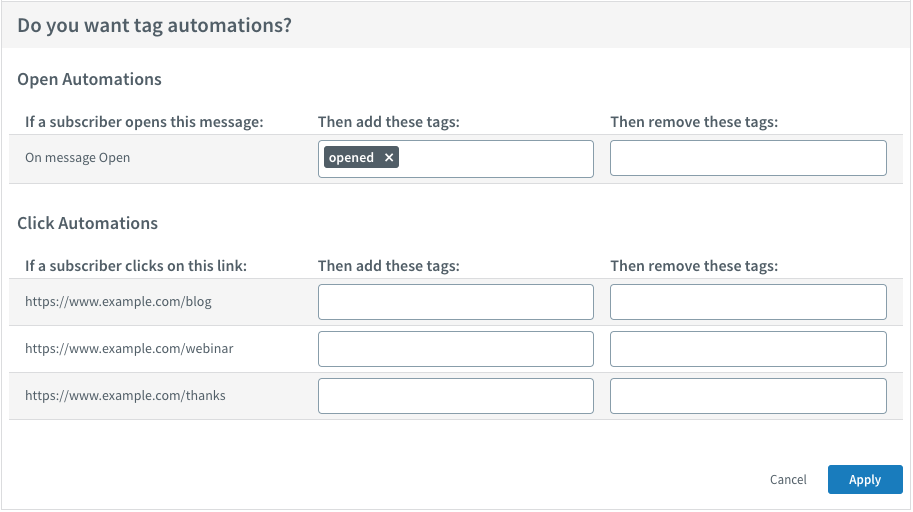
Related: How to tag someone who opens a broadcast
15 - Clicks a link in a broadcast email
If you’re promoting an upcoming webinar in a broadcast email, you can tag anyone who clicks the registration link and send them an automated email with the link to join the webinar. This improves the subscriber experience by eliminating the need to fill out another form to sign up for the webinar.
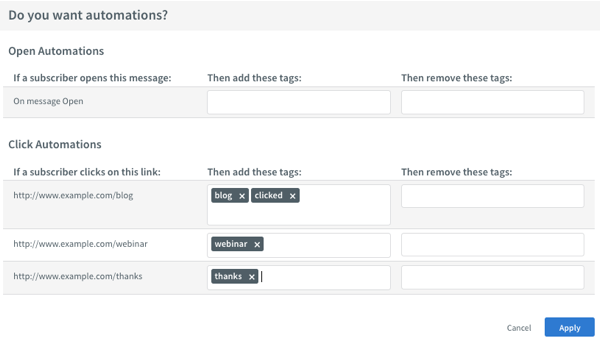
Related: How to tag someone who clicks a link in a broadcast
Now that you know how you are able to add tags to your subscribers, start thinking about
How to segment using tags?
If tags are subscriber categorizations, segments are groups of subscribers based on category.
For example, someone chooses "vegan," on your contact form, you can tag them and then create a segment of "vegans" to send specific content to.
There are many ways to segment your subscribers: tags, location, behaviors, and more. But tags are one of the easiest way to create segments that are useful for sending emails your subscribers will actually like.
Here's how to segment your subscribers in AWeber:
1. Click into the Subscribers section of your dashboard.
2. Search for a group of your subscribers (based on tags if you're using them to create your segment).

3. Save the search as a segment.

When you're sending a broadcast, you can choose to send only to a certain segment:

So a cookbook sales email targeted specifically to vegans won't end up in the inboxes of meat-eaters, and vice versa.
Related video: How to create subscriber segments using tags.
Creating more targeted segments (or groups) of subscribers can help you achieve higher email open and click rates, better email deliverability, and more sales.
Start using tags today.
Using tags to organize your subscribers enables you to provide a more personalized experience for your subscribers and increase your engagement. Not an AWeber customer yet? Get started with AWeber free today and try AWeber’s tags today.
The post Email Tagging Tips to Skyrocket Your Open Rates appeared first on AWeber.
from AWeber https://ift.tt/3IdK4oh
via IFTTT
No comments:
Post a Comment